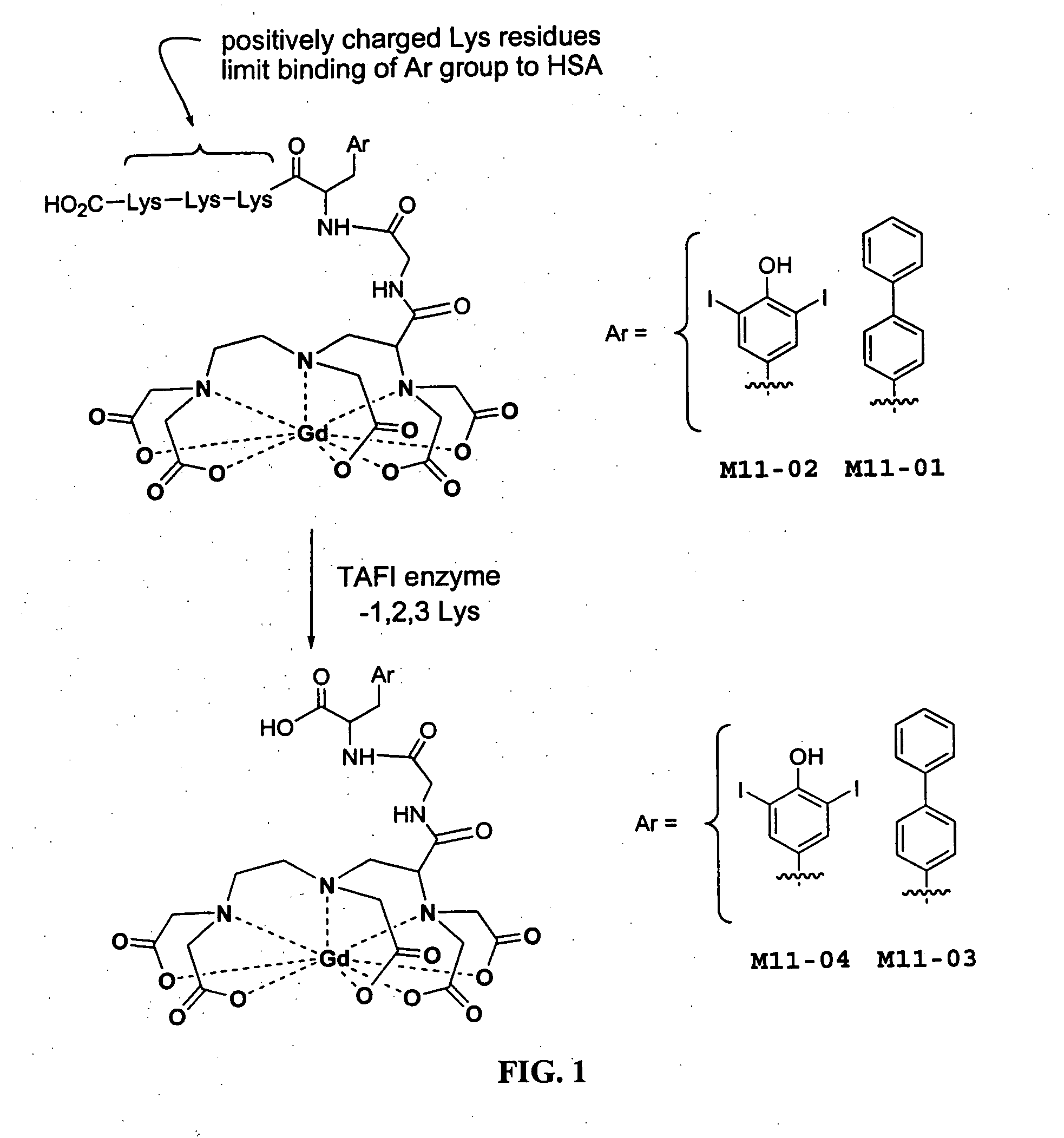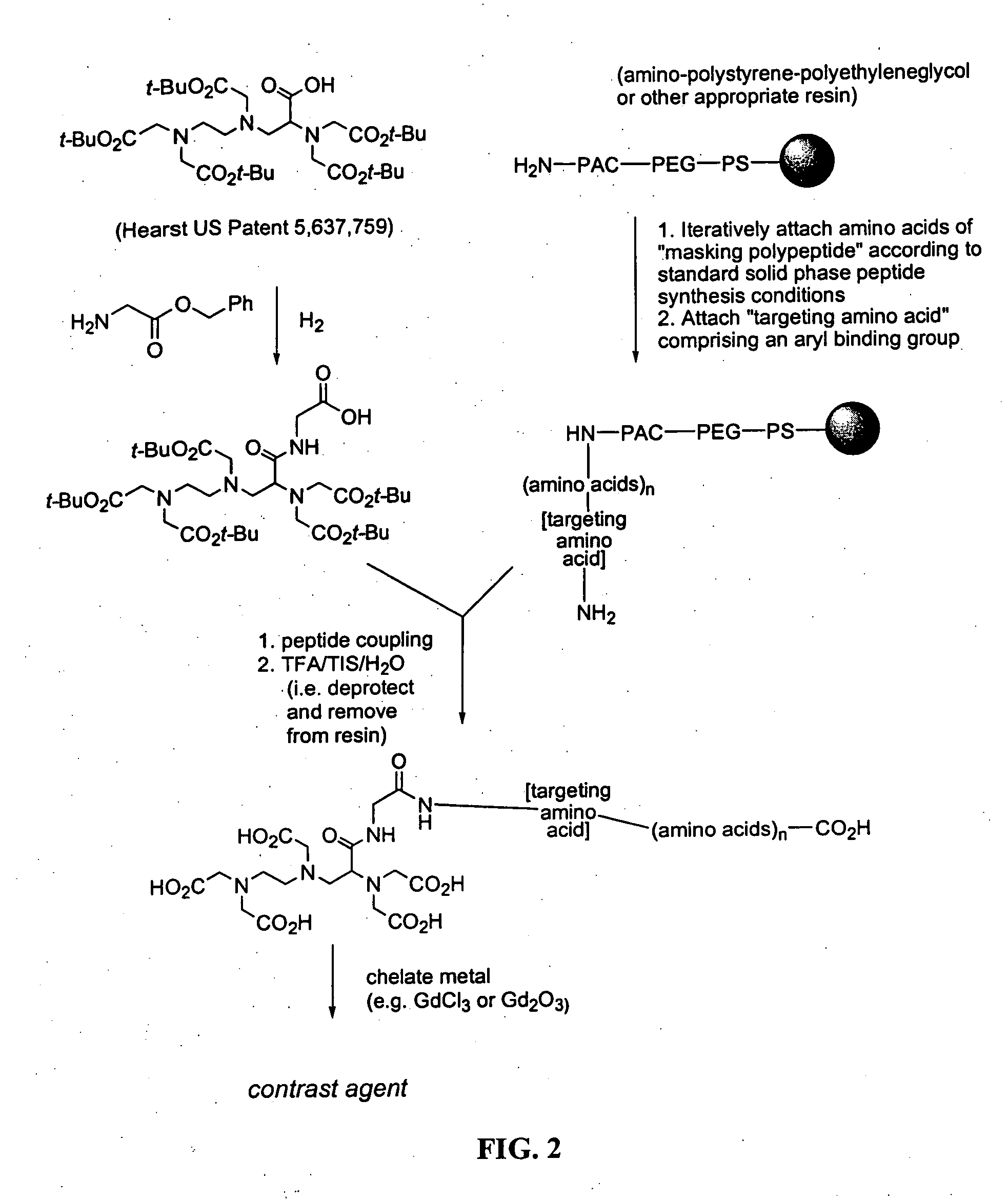[0035] In general, the degree of
toxicity of a
metal chelate is related to its degree of dissociation
in vivo before
excretion.
Toxicity generally increases with the amount of free
metal ion; that is, a high formation constant is preferred to prevent toxic concentrations of free
metal ions.
[0040] One attribute of the present invention is a binding group that comprises an
amino acid side chain. Such a binding group allows simplified synthesis of the contrast agent since the agent can be synthesized using standard
peptide synthesis techniques.
[0044] The preferred embodiments of the present invention contain a cleavable polypeptide group that is cleaved
in vivo. Preferred embodiments comprise cleavable groups that are cleaved by an
enzyme selected from the
Thrombin Activatable
Fibrinolysis Inhibitor (TAFI), a member of the
Carboxypeptidase B family,
trypsin, Factor Xa, 7B2
protein,
proprotein convertase 2,
subtilisin,
kexin endoproteinase, pancreatic
carboxypeptidase, Endoproteinase Lys-C, Myxobacter
Protease,
elastase, matrix metalloproteinases (MMPs), Clostripain, and
Armillaria Protease. The invention further contemplates the use of other enzymes known to site-specifically cleave peptides, such as
chymotrypsin, especially when the masking polypeptide includes positively charged terminal amino acids. The most preferred embodiments comprise cleavable groups that are cleaved by the proteolytic
enzyme TAFI, a member of the
Carboxypeptidase B class of
proteolytic enzymes. TAFI acts
in vivo by cleaving C-terminal lysines exposed on
fibrin. After
fibrin is cleaved in vivo, clot degradation by
tissue plasminogen activator and plasminogen is inhibited. Following cleavage of the contrast agents of the present invention by the TAFI
enzyme, the contrast agents bind more tightly to the
target protein resulting in increased relaxivity and improved
image contrast.
[0045] Screening of a large number of candidate contrast agents has previously shown that incorporating
aryl groups into the structure of traditional
gadolinium polyaminocarboxylate ligands, such as
DOTA or DTPA, results in improved binding of the contrast agents to HSA. To maximize relaxivity, binding groups should not be placed more than about 20 carbon-carbon bond lengths from the metal center since the additional intervening atoms provide additional flexibility to the molecular structure, which in turn may allow increased, undesirable molecular tumbling or increased motion of the chelated paramagnetic metal
ion at the
chelation site. Any decrease in molecular tumbling or chelate motion will result in increases in relaxivity. Therefore, the
linker between the
chelation ligand and the targeting amino acid should be relatively short.
[0046] Contrast agents containing a masking polypeptide comprising positively charged amino acids (e.g.,
lysine,
arginine,
ornithine, 2,4-diaminobutanoic acid, 2,3-diaminopropionic acid or other residues) bind less tightly to HSA and exhibit lower relaxivity in aqueous media containing HSA than contrast agents lacking positively charged amino acids. Positive charges significantly attenuate the affinity of the molecule for HSA. Cleavage of the charged amino acids by an appropriate enzyme (e.g., TAFI which cleaves
polylysine), therefore permits the contrast agent to bind more tightly to HSA.
Tight binding of the contrast agent to HSA results in increased relaxivity. The
peptide is preferably covalently attached to the
linker / chelate via its N-terminus. This leaves the negatively charged C-terminus exposed and allows the
peptide to be cleaved by a
carboxypeptidase. After such cleavage and removal of positively charged amino acids, the remaining negatively charged
carboxylate group may facilitate binding of the “unmasked” agent to HSA. III. Examples
 Login to View More
Login to View More 


